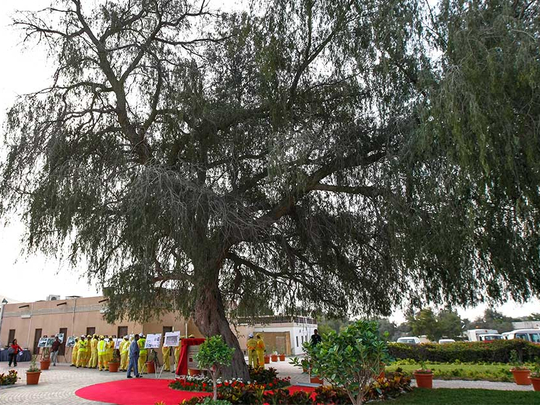
Dubai
Think twice about chopping down that old ghaf tree in Dubai, warned Dubai Municipality on Sunday.
Under an ongoing programme to take stock of and preserve the valuable desert trees in the emirate, those found damaging ghaf trees will face action by the municipality — tampering with the trees is against the law.
Under what is called the Aged Trees Numbering Project. municipal staff will fan out in the new year across rural stretches of the emirate to count aged ghaf trees to protect them from human predation and to preserve them as a key weapon against desertification, said officials.
The effort is underway, the municipality said, following reports of “cutting of ghaf trees in several areas by the people to benefit from the timber, and the increased number of offences recorded against the public by the plantation protection inspectors”.
As part of the project, the system will assign a special number to each ghaf tree, depending on its location and condition, and will permanently affix the tree with a metal plate declaring that, “This tree is protected by law”.
The desert quest by municipal staff in the new year marks the second phase of the Aged Trees Numbering Project by Dubai Municipality which, to date, has already identified 5,972 older ghaf trees in the urban areas of Dubai of a total 10,000 trees counted.
Mohammad Al Awadi, Director of Public Parks and Horticulture Department of the Municipality, said in a statement that ghaf trees multiply rapidly, and it has several advantages in the fight against shifting sand dunes to other areas in addition to being alive long periods of time.
He said the horticulture department will begin monitoring the ghaf trees in the rural areas within the second phase of the project during the first quarter of 2017.
“Since 2014 the Municipality has been managing 5,972 ghaf trees, located in the 11 urban districts of Dubai, which were among the 10,000 trees we had enumerated at the beginning of the project. We had spotted all the trees in the emirate, including affected by the transfer of positions to others sites outside the city because of infrastructure development,” said Al Awadi.
“The recording of all the trees is expected to be completed in the first phase, which includes the urban areas during the first quarter of next year. Then we will start monitoring the aged ghaf trees in the rural area, which may need more time, considering the bigger number of trees and larger area than the urban region,” he said.
The project provides an e-database with statistics about the aged trees, which is easily updated periodically and linked with the Dubai Statistics Centre to have the statistics about the aged trees of local environment at the centre’s disposal.
The database will log details such as the condition of the trees and coordinates of their location, the number of aged trees, their age, length and diameter of the trunk and the types of injuries suffered by them.
By the numbers
Under the first phase of the Aged Trees Numbering Project within the urban areas of Dubai, the number of trees counted since 2014 are:
• 3,200 trees in the Nad Al Sheba area
• 1,331 in Zabeel
• 626 in Satwa
• 386 Al Quoz and Al Sufouh
• 169 in Bu Qadra
• 148 in Al Barsha
• 57 in Al Kifaf
• 45 in Jumeirah and Umm Suqeim
• And, 10 trees in Oud Metha.
SOURCE: Dubai Municipality












